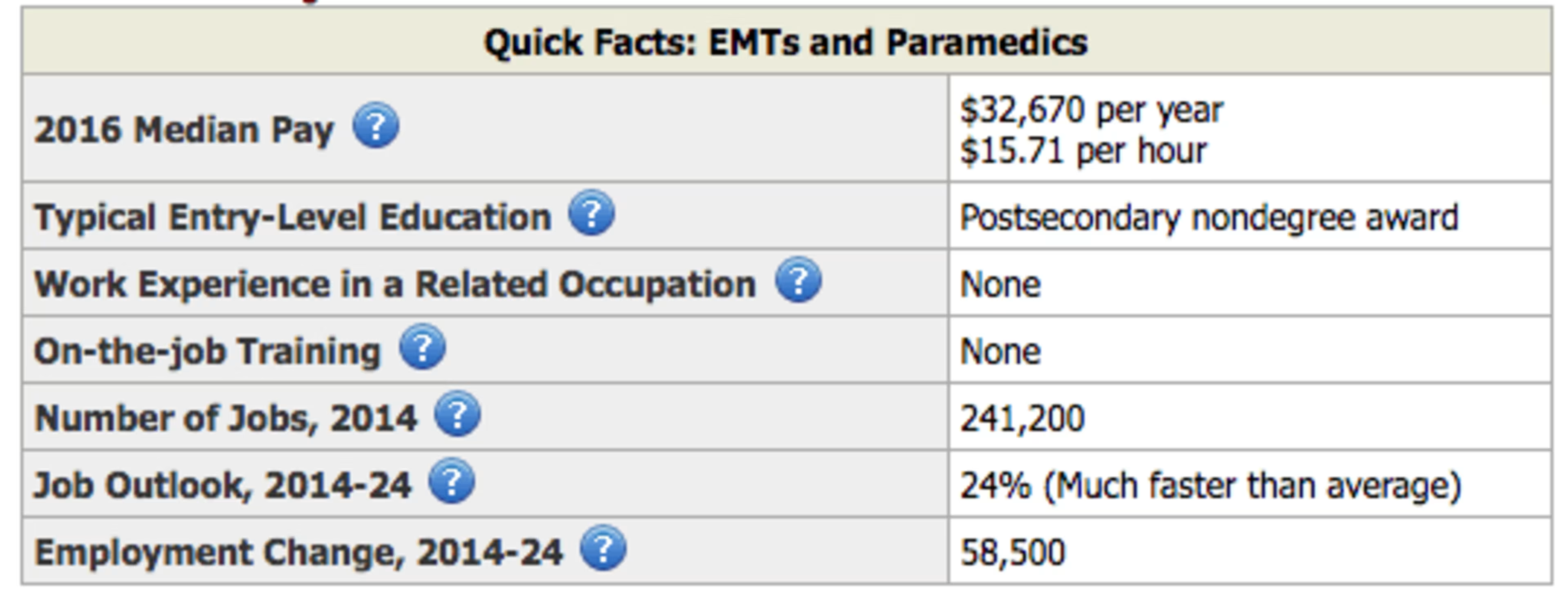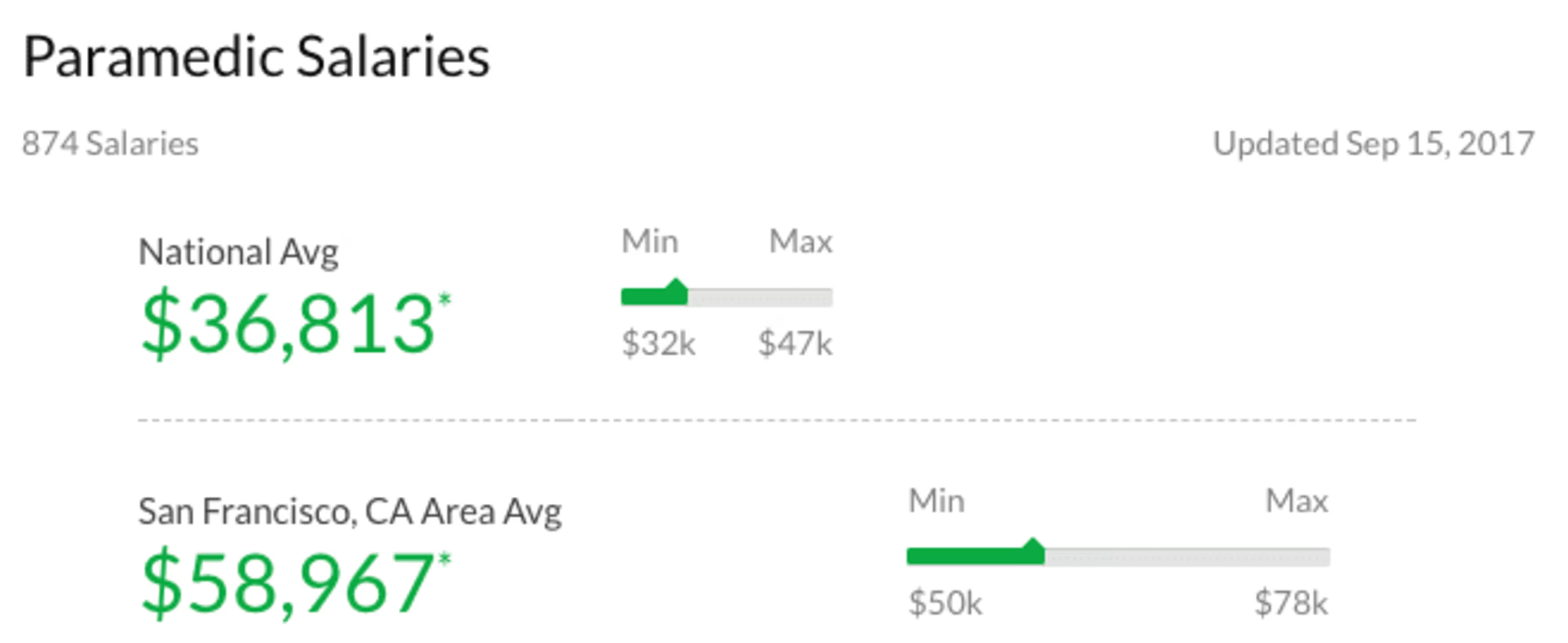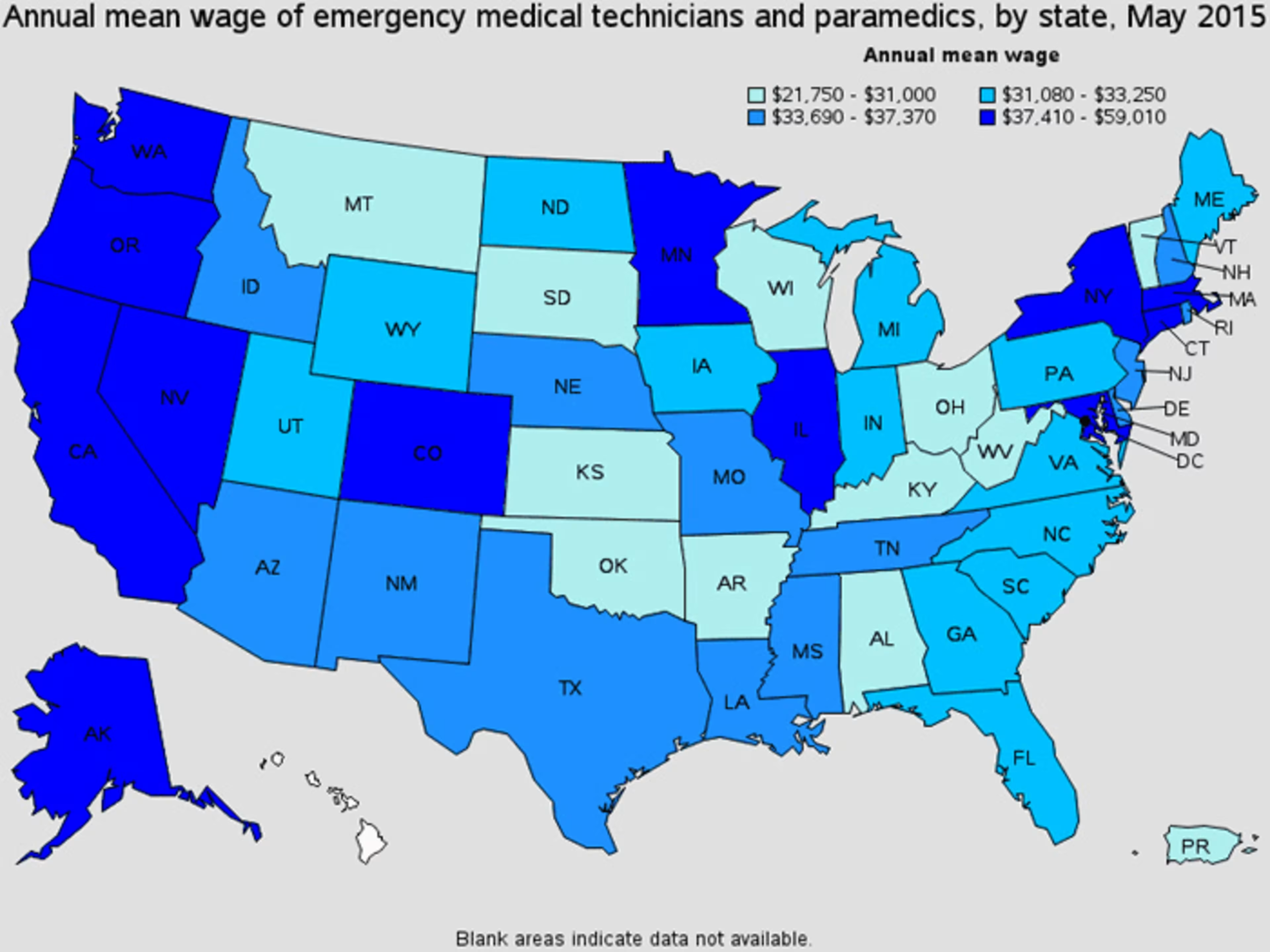The average annual salary for an emergency medical technician (EMT) is $32,238 as of September 2017, according to Glassdoor.
Numbers alone can't tell the whole story; what you should be earning as an EMT depends on experience, geography, and other factors.
Let's examine what EMTs like you are making, and how you can earn more.

The EMT landscape
What EMTs earn
The Bureau of Labor and Statistics (BLS) maintains average salary numbers and job information for EMTs and paramedics in its occupational outlook handbook.

2016 BLS occupational outlook handbook statistics for EMTs and paramedics
The BLS lists the 2016 salary range for EMTs and paramedics as $21,240-$56,310.
According to Glassdoor, paramedics—on average—earn slightly more ($36,813 / year) than EMTs ($32,238).
Growth prospects
The BLS expects employment prospects for EMTs and paramedics to grow much faster than the average for all occupations in the US, anticipating a 24% increase in the number of jobs by 2024.

BLS projected job outlook for EMTs and paramedics
Best places to work
Like most fields, geography plays a significant role in EMT earnings caps. For example, EMTs in San Francisco earn average annual salaries of $38,289—$6,051 more than the national average.
For paramedics, geography plays an even larger role in average annual salaries. The difference between the national average and the average is San Francisco is a whopping $22,154.

Paramedic salaries, via Glassdoor
Monster lists Nevada as the state with the highest average hourly wage for EMTs and paramedics ($35.85/hour) and Oklahoma as the lowest ($14.77/hour).

Salary ranges for EMS workers by state as of 2015 (via EMS1.com)
5 ways to increase your annual earnings
It's a fortuitous time to work in the emergency medical service providers field, with high demand for EMTs and paramedics showing no sign of slowing. But how do you translate high demand into a commensurate salary?
Read on for five ways you can take action to increase your annual earnings.
1. Become an EMT-Intermediate
Certain states offer an EMT-Intermediate, EMT-B, or AEMT license, a step between EMTs and paramedics. Professionals holding such licenses are permitted to perform procedures and administer more medications than EMTs. This license requires additional training and some field experience but can increase job security. Pay varies widely, but is generally higher than an EMT salary.
2. Advance in your career
A paramedic is the most advanced (most training, most responsibility) non-hospital provider. Paramedics have additional skills and experience when compared to EMTs and can work in a myriad of settings, such as medical helicopters and wilderness emergency medical services (EMS).
You'll need to take a paramedic course to get your license; most courses have a prerequisite of six months of EMT experience.
Paramedic courses can require 1,200 to 1,800 hours of training, generally consisting of at least 700 hours of classroom work and lectures in addition to hands-on skills training and clinical or field internships. In most states, you must get certified as a paramedic within two years of completing a paramedic course.
3. Look for a new employer
EMS (encompassing EMT and paramedic roles) pay also differs by employer type (e.g. hospitals, local governments, or ambulance services).

Median annual wages for EMTs and paramedics by employer type as of 2016 (via BLS)
According to EMS1.com, while private ambulance companies generally pay the least they can be a good way to gain experience as they're often willing to hire newer or less-experienced EMTs.
Hospitals fall in the middle of the pay scale; they hire EMTs and paramedics to perform IV pump infusions and ventilator management while transporting critical care patients between medical facilities. Hospitals also may require EMTs to perform certain RN duties.
For the highest pay, look to government agencies such as fire departments, state police departments, the National Park Service, and state ambulance services. Be aware going in that these jobs are in high demand and often require more education and experience than other employers.
4. Work more overtime
According to EMS1.com, in 2014 about one third of EMTs surveyed reported working more than 40 hours per week at an overtime rate.
“Don't underestimate how much this is," EMS1.com writes. “At least one paramedic doubled her salary by taking overtime shifts, and another paramedic made more money than the mayor of Baltimore by staying on the clock."
But don't just put in more hours. Consider working with your manager to expand your responsibilities with something like the following ideas:
Tap into a new transport market to expand your organization's reach.
Reduce vehicle service and maintenance expenses by testing a new protocol or finding a new service provider.
If your team offers a continuing education program, turn it into a paid online CE provider.
Turn your workplace into a critical care transport service provider.
5. Find a second job
While finding a second job to increase your annual wages seems obvious, there are several EMT-focused resources that provide information on supplemental work that can boost your resume. EMS1.com lists teaching, security, and personal training as examples of popular EMT side jobs.
Your EMT training makes a variety of teaching jobs feasible, such as:
Newbie EMS coach
CPR instructor
Hazmat trainer
Street drug recognition expert
On the EMT Life forum, EMS workers suggest home health aide and paid companion as second jobs; seniors and their caregivers often prefer to hire individuals with medical training so they can provide or recommend care as necessary.
Another possible side gig is EMS equipment broker. EMS providers frequently need new equipment, and you know what works and what doesn't. FlightSafetyNet.com suggests approaching your favorite EMS equipment companies and offering to endorse and sell their equipment through local demonstrations. “They'll appreciate someone local they know and trust answering their questions. Charge a pre-set fee or commission, or both, for your services."
Conclusion
Ultimately, budget woes aside, pay comes down to value provided. If you can enhance your skill set and identify ways to provide more value to your employer, you can make a case for a raise or general compensation base increase.
If you're on the employer side, check out these HR pieces for some resources on how to make things work from your end:
5 Recruiting Myths That Could Be Holding Your Company Back
How to Use Psychology to Increase Your Employee Retention Rate
Are the salaries cited here what you're making as an EMT? Have you had any success increasing your annual salary or obtaining a raise? Did you start out as an EMT before opting to become a paramedic?